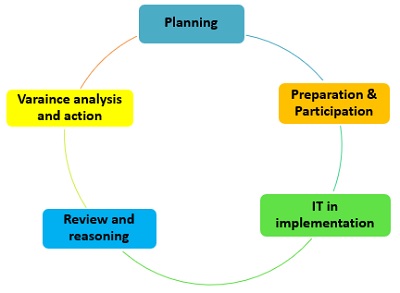As I already stated in my introductory part of this topic, any process will be parted into static and strategic meaning thereby one which is in as it is form and the other requires professional skepticism. Above that, static facts w.r.t. terminologies are also tuned here. Let us sail beyond statutory sections sight u/s 134, 143,177 of Companies Act, 2013 by carving into crux of HR worker & staff process.
Draft design depicted as: –
- Radical round
- Building base
- Strata static sphere
- Review rack
- Holistic Heed
- Radical Round
 Boosting buzz of the boss to give data in their own bias basis and whooping wish list of xyz department to spend significant sight beyond sanctioned are the starting stands which ink its insights to the importance of process- planning, budgeting and management information system (MIS). This finds its way in almost all other processes of IFC as it becomes “the beginning base”.
Boosting buzz of the boss to give data in their own bias basis and whooping wish list of xyz department to spend significant sight beyond sanctioned are the starting stands which ink its insights to the importance of process- planning, budgeting and management information system (MIS). This finds its way in almost all other processes of IFC as it becomes “the beginning base”.
Incepts at planning stage with execution and participation of all stakeholders after aligning system sync mixed by monitoring it at regular intervals with outcome of preventive or corrective call from data derived to make decision via MIS.
- Building Base
It starts with “the format” required to give bird’s eye view to management and how data will be filled into it to derive meaningful information. Budget basics have standard component like projections, growth percentage, external factors of inflation, market movement, any aspect affecting business model and its expansion, actual inputs to estimates used analysis, range of a period, trend considered, etc. Secondly, bifurcation of budget must be demarcated. Sales, capex, labor, production, financial, marketing, HR or under umbrella of master, finance, operating and overheads, it could be any combinations. This gives weightage of certain departments in direction to the business environment in which company operates.
Brainstorming amongst departments is the breakthrough. If it is not the 1st year of the company to conduct, design, draft, or test IFC, a glance at its past trends posts the pic precisely.
E.g., A situation where it is observed that marketing expenses have been running in ad-hoc approval mode for the past 2 years.
Possibilities could be: – (a) Input given by the team at planning stage needs to be reconsidered with realistic review (b) Does the time of 2 years include exceptional scenarios? – A pandemic, Govt restrictions like hoarding ban in market contributing major revenue and cost incurred likely to be sunk cost due to vernacular language used in marketing materials. (c) Less allocation to the marketing department despite budgeted outflow factored at 0.(1234..)% less. (d) top management movement in the said department may impact strategies to support the budgeted figures. Thus, the importance of cross-sectional stakeholders to seek in- depth view beyond figures and trends.
MIS- a format with frequency set to mingle matching concept clarity for setting tone at the top. Here also it is ‘the industry’ under review which defines scope of budgeting and MIS.
E.g. for a bank, MIS needs to be prepared by a semi-skilled staff due to sensitivity of information to peers while for any FMCG sector a dedicated team from preparation stage at skilled staff is sourced.
Thus, building base begins with brainstorming and bandwidths till board meeting.
- Strata-static sphere
Consists of: –
1. SOP
2. Static seven
1. SOP
SOP for this module mostly talks about synergy among departments to draw budget. A flow distinguishing share of each part of organization in terms of allocation. Internal resources and factors to be referred to and external environment inclusion at in-prompt phase or prolonged are to be planned.
2. Static seven
Following seven points which are statistically significant: –
I. List of type of budget and its share in master budget.
II. Relevant stakeholders’ inclusion and person responsible to provide inputs till approval end.
III. Pre and post approvals for excess/deficit funds aligned to SOD/DOA matrix.
IV. Statutory compliance corner in terms of approved board meetings and applicable framework requirements to be refereed to.
V. Back up of data as part of business continuity plan.
VI. Utilization of budget for which it is set out i.e., cross utilization of amounts. Inter transfers and related party portions to be precisely looked at.
VII. Cash /fund positions and their separate or integral SOP to be taken at substantive sight.
- Review Rack
Rest assured it will reviewed! Is this statement restricted only in cases where actuals exceeded budget? Yes, it’s a must measure as part of corrective action, but review rack range represents round table reactions. There needs to be frequency set for review and action plan documented for variance analysis.
System controls, the role of IT in implanting budget needs to be tested. A scenario of system controls from testing outcome basis.
- Effective: System is managed in such a way that no component is unlinked to enter the amount more than approved budget except via IT ticket in case of revised approvals, which is again aligned to approvals at par with SOD matrix.
- Partially effective: Components are so mammoth for an industry that not entire module works on preventive path. Capex can be configured in system as it has limited components to cater the needs while for opex system cannot be mapped to miniscule level. However, review rack is so strong that opex is aligned to approved figures. So, capex IT controls are strong while opex system is used merely to abstract reports.
- Ineffective: No role of IT in budget and controlling. Only used to abstract data. There exists a deficiency on account of system sync.
Review rack is not restricted to re-work, it considers scenario of route which is adopted to analyze outcomes of budgeted vs actual vs external or ad-hoc situations with in-prompt, preventive and corrective path perceived.
- Holistic Heed
Budget and MIS being the best tools of decision making takes process point to pervasive view. Considerable time is spent to frame the budget in line with the vision of the company. There are instances inclined for mid-size or big companies that budget partakes in one of key performance indicators (KPI). Holistic heed to be paid as process owners are mostly those charge with governance.






